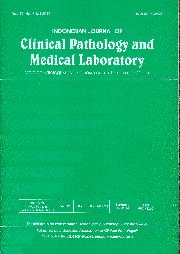Indonesian Journal of Clinical Pathology and Medical Laboratory
ISSN 0854-4263
Vol. 19 / No. 3 / Published : 2013-01
Order : 11, and page :197 - 203
Related with : Scholar Yahoo! Bing
Original Article :
(c3c serum complement and blood t-cd4+ lymphocyte)
Author :
- I. Komang Parwata*1
- Endang Retnowati*2
- Betty Agustina Tambunan*3
- Patologi Klinik FK UNAIR-RSUD Dr Soetomo- Surabaya
- Patologi Klinik FK UNAIR-RSUD Dr Soetomo- Surabaya
- Patologi Klinik FK UNAIR-RSUD Dr Soetomo- Surabaya
Abstract :
The incidence of HIV and AIDS infection continues to increase despite various treatments have been applied, thus the mortality rate remains high. The examination of CD4+ T lymphocytes number to determine the immune status and the monitoring of therapy has some limitations in facilities and personnel examination as well as expensive costs. The decrease in CD4+ T lymphocytes number will be followed by an increase in the virus number and complement activation, so that the C3c complement levels will decrease. The purpose of this study was to know the correlation between C3c complement serum levels and CD4+ T lymphocytes number in stage I HIV-infected patients by determining them. This research is an observational cross-sectional study. Thirty samples of stage I HIV-infected patients at the UPIPI of Dr. Soetomo Hospital were included in this study; they were collected between July and August 2011. HIV diagnosis was confirmed by positive HIV test results using three different methods. The CD4+ T lymphocytes number were examined using flowcytometry (FACS Calibur, Becton Dickinson (BD) Diagnostics) and complement C3c using Radial Immunodiffusion (NOR Partigen * C3c, Siemens). The results of complement C3c serum levels and CD4 + T lymphocytes number were analyzed with Pearson’s correlation and regression test (Pearson Product Moment Correlation) and Spearman’s Correlation test. The majority (83.33%) of C3c complement levels in stage I HIV-infected patients was still within normal limits (0.55 g/L up to 2.01 g/L; mean 1.39 g/L, SD 0.313 g/L) while the majority of CD4+ T lymphocytes absolute number (80%) were decreased (24-567 cells/µL; mean 295 cells/µL, SD 177 cells/µL). Based on a percentage value of CD4+ T lymphocytes, the majority (86.67%) decreased (2.54-29.48%; mean 13.58%, SD 6.7%). In this study was found that no significant correlation exists between C3c complement and CD4+ T lymphocyte absolute number with p = 0.130 and percentage with p = 0.217. There was no significant correlation of C3c complement and CD4+ T lymphocyte. This means that C3c complement examination can not be used to predict CD4+ T lymphocytes number. Angka kejadian infeksi HIV dan AIDS terus meningkat meskipun berbagai upaya sudah dilakukan. Namun, belum berhasil sepenuhnya, sehingga angka kematian HIV tetap tinggi. Pemeriksaan jumlah limfosit-T CD4+ adalah untuk mengetahui status imun dan menentukannya, serta memantau pengobatan yang memiliki keterbatasan sarana, berikut tenaga dan biaya pemeriksaan yang mahal. Penurunan jumlah limfosit T-CD4+ akan diikuti dengan peningkatan jumlah virus dan aktivasi komplemen, sehingga kadar yang terkait C3c akan menurun. Tujuan penelitian ini adalah untuk mengetahui kenasaban antara kadar komplemen serum C3c dengan jumlah limfosit T-CD4+ di penderita yang terinfeksi HIV tahap I. Penelitian bersifat amatan potong silang dengan jumlah sampel 30 penderita yang terinfeksi HIV tahap I yang dirawat di ruang UPIPI RSUD Dr. Soetomo Surabaya pada bulan Juli sampai Agustus 2011. Diagnosis HIV ditetapkan berdasarkan hasil uji HIV positif menggunakan tiga cara yang berbeda. Pemeriksaan jumlah limfosit T-CD4+ dilakukan dengan metode flowcytometry (FACS Calibur, Becton Dickinson (BD) Diagnostic) dan komplemen C3c dengan radial immunodiffusion (NOR Partigen* C3c,Siemens). Hasil periksaan kadar komplemen serum C3c dan jumlah limfosit-T CD4+ dianalisis dengan uji kenasaban dan Spearman (Spearman’s Corellation test) serta regresi Pearson (Pearson Product Moment Correlation). Kadar komplemen C3c di penderita terinfeksi HIV tahap I sebagian besar (83,33%) masih dalam batas normal (0,55 – 2,01 g/L; rerata 1,39 g/L; SD 0,313 g/L), sedangkan jumlah mutlak limfosit T-CD4+ sebagian besar (80%) menurun (24-567 sel/µL; rerata 295 sel/µL; SD 177 sel/µL). Berdasarkan nilai persentase, sebagian besar (86,67%) menurun (2,54- 29,48%; rerata 13,58 %; SD 6,7%). Pada penelitian ini tidak ditemukan kenasaban yang bermakna antara komplemen C3c dengan jumlah mutlak limfosit T-CD4+, p = 0,130 dan persentase dengan p = 0,217. Pada penelitian ini tidak ditemukan kenasaban yang bermakna antara komplemen C3c dan limfosit T-CD4+, sehingga pemeriksaan terkait C3c tidak dapat digunakan sebagai alat pemeriksaan yang mencerminkan jumlah limfosit T-CD4+.
Keyword :
Complement C3c, CD4 + T lymphocytes,
References :
Departemen Kesehatan R.I. ,(2011) (Komisi Penanggulangan AIDS). Strategi dan Rencana Aksi Nasional Penanggulangan HIV dan AIDS 2010-2014 Jakarta : Departemen Kesehatan R.I.
World Health Organization (WHO),(2007) Review of the Health Sector Response to HIV and AIDS in Indonesia Geneva : World Health Organization (WHO)
Yefenof E., Asjo B., Klein E,(2011) Alternative complement pathway activationby HIV infected cells: C3 fixation does notlead to complement lysis but enhances NKsensitivity. International Immunology USA : Oxford University Press
Abbas A. K., Lichtman A.H., Pober J.S,(1994) Cellular and Molecular Immunology: The Complement System Boston Massechusetts : W. B. Saunders Company
Blue C.E., Spiller O.B,(2004) Blackbourn D.J. The relevance of complement to virus biology USA : Virology
Archive Article
| Cover Media | Content |
|---|---|
 Volume : 19 / No. : 3 / Pub. : 2013-01 |
|












